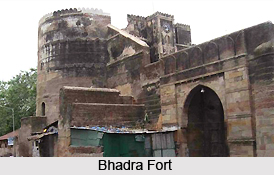 Bhadra Fort in Ahmedabad takes its name from the goddess Bhadra, an incarnation of goddess Kali. It was established in 1411 by Ahmad Shah. The city of Ahmedabad is known after its ruler, Ahmad Shah. After waging wars on the native rulers, the Ahmad Shahi dynasty ruled the region for around 150 years. It was believed that the Bhadra fort proved to be quite fortunate for the rulers as well as for the city. Ornately decked up, it is a popular belief that Goddess Lakshmi (goddess of wealth) visited the fort. And it was due to this that the city prospered and still continues to be an important centre for trade and commerce in the state of Gujarat.
Bhadra Fort in Ahmedabad takes its name from the goddess Bhadra, an incarnation of goddess Kali. It was established in 1411 by Ahmad Shah. The city of Ahmedabad is known after its ruler, Ahmad Shah. After waging wars on the native rulers, the Ahmad Shahi dynasty ruled the region for around 150 years. It was believed that the Bhadra fort proved to be quite fortunate for the rulers as well as for the city. Ornately decked up, it is a popular belief that Goddess Lakshmi (goddess of wealth) visited the fort. And it was due to this that the city prospered and still continues to be an important centre for trade and commerce in the state of Gujarat.
As far as the other monuments inside the citadel are concerned, on the east side of the citadel, facing the Teen Darwaza, lies the Palace of Azam Khan (1635-42), nicknamed `the white ant` for his love of building. It is now used as a post office. Over the gateway the date 1636 AD is engraved. The north entrance to the Bhadra is through an archway and opens out into a large octagonal hall, containing an arched gallery in the upper level, enclosed by a low wall of pierced stone. Each gallery is crowned by a cupola. Beneath the hall is a lofty vaulted chamber with a fountain and tank to the centre.
Mosque of Sidi Sayyid (1572-3) stands in the north-east corner of the citadel and once formed part of the city walls. It has been attributed to a slave of Ahmad Shah I, but the architectural style, form and composition suggest a much later date and it is now accredited to a distinguished noble of the time of Sultan Muzaffar III (1561-72). It is famous for its ten carved, semicircular windows enclosed with exquisite tracery in the form of tree stems and branches. Those on the western wall are considered to be the finest examples of carved stone tracery in India, surpassing even those in Agra and Delhi. Internally, eight pillars divide the space into fifteen bays, crowned by domes of differing styles.
In the south-west corner of the Bhadra citadel is Ahmad Shah`s Mosque (1414) and was once used as the sultan`s private place of worship. As one of the oldest mosques in the city, it is of interest as it is a Muslim composition with internal features of Hindu and Jain origin. The facade is plain, with incomplete minarets. The hall is three bays wide, with four other arched openings besides the central entrance. Eight perforated stone windows light the interior. To the northwest is the zenana enclosure, distinguished by twenty-five richly carved pillars. The entrance porch leading to it may be a remnant of an earlier temple on the site. Note the central mihrab on the west wall, with its fine black and white marble casing. On the platform opposite the sultan recited his prayers.
Close to the Khan Jahan Gate in the south-west corner of the citadel is Khan Jahan`s Mosque (early 16th century), with an open pillared facade and low ceiling. At each end arc thin minarets. In front of the mosque is a single pavilion, believed to be the grave of Khan Jahan.
The Ganj-i-Shahid immediately to the left of the entrance is the martyrs` burial ground.
To the north is the Manik Burj or Ruby Bastion, incorporating the foundation stone of the city. The small circular tomb next to the Collector`s Office is alleged to be that of the Persian warrior Ibrahim Quli Khan.
The Tomb of Shah Wajih-ud-Din (1609) is a fine Muslim sepulchre, worthy of note, built by Saiyad Murtaza Khan Bokhari, the 11th viceroy.
The Mosque of Sayyid Alam (1412) was built by Abubakr Husaini and is one of the first to have been erected in the city. Architecturally, it comes at the earliest stage of the provincial style, with rich Hindu decoration and motifs, three arched entrances of equal height, a higher central wing and multi-storey balconied minars.
The Mosque, Tomb and Madrasa of Shujaat Khan (1695) stand close to the Lai Gate of the Bhadra. The Marble or Ivory Mosque has two thin minarets, with a frontage of five bays divided by piers. The inscription over the qibla is the date. The walls are lined to dado level with marble.



















